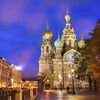9 Nights | Europe
About Oslo, Norway
You will visit the following 7 places:

Copenhagen
Copenhagen is the capital and largest city of Denmark. This "friendly old girl of a town" is big enough to be a metropolis with shopping, culture and nightlife par excellence, yet still small enough to be intimate, safe and easy to navigate. Overlooking the Øresund strait with Sweden just minutes away, it is a cultural and geographic link between mainland Europe and Scandinavia. This is where old fairy tales blend with flashy new architecture and world-class design; where warm jazz mixes with cold electronica from Copenhagen's basements. You'll feel you've seen it all in a day, but could keep on discovering more for months. Copenhagen is considered a very liveable place because of its cleanliness. It’s considered as one of the very environmentally friendly cities because its harbour can be swum in and about a third of the city’s people use bicycles as their means of transportation. In their downtown area, the places to visit and to be entertained at are the Tivoli gardens and the Town Hall Square. If you want the very cultural and scenic areas the places to see are the Marble church, the Rosenborg castle, and the Christiansborg.

St Petersburg
Saint Petersburg is a city and a federal subject (a federal city) of Russia located on the Neva River at the head of the Gulf of Finland on the Baltic Sea. In Russian literature, informal documents and discourse, the word "Saint" is usually omitted, leaving "Petersburg". The city is often described as the most Westernized city of Russia, as well as its cultural capital. It is the northernmost city in the world with a population of over one million. The Historic Centre of Saint Petersburg and Related Groups of Monuments constitute a UNESCO World Heritage Site. The city is home to The Hermitage, one of the largest art museums in the world. A large number of foreign consulates, international corporations, banks, and businesses have offices in Saint Petersburg. Talking of churches, Church of the Savior on the Blood is said to be the most beautiful church in St. Petersburg. Built of beautiful mosaic and stonework, the church gives you an indication of how ancient Russia looked like. The church is built at an equally historic spot. This is where Tsar Alexander II was assassinated in the year 1881.

Oslo
Oslo is a county and municipality, as well as the capital and largest city in Norway. Oslo was established as a municipality on 1 January 1838. Founded around 1048 by King Harald III "Hardraade" of Norway, the city was largely destroyed by fire in 1624. The Danish–Norwegian king Christian IV moved the city, rebuilding it closer to Akershus fortress, as Christiania (briefly also spelt Kristiania). In 1925, the city reclaimed its original Norwegian name, Oslo. The diocese of Oslo is one of the five original dioceses in Norway, which originated around the year 1070.

Stockholm
Stockholm - Sweden's capital and largest city, and the most populous city in the Nordic region. Without a doubt, Stockholm is one of the most beautiful cities in Europe. The city is made up of 14 islands connected by some 50 bridges on Lake Mälaren, which flows into the brackish Baltic Sea, and passes the Stockholm archipelago with some 24,000 islands and islets. The city is a cosmopolitan place with both classical and modern architecture, and a captivating Old Town, Gamla Stan. Today, the area is an atmospheric mixture of buildings surrounded on all sides by a latticework of medieval lanes and alleyways.

Aalborg
Aalborg is a Danish industrial and university city in North Jutland. The city of Aalborg has a population of 102,312 making it the fourth largest city in Denmark in terms of population. The municipality of Aalborg has a population of 197,426 (2010) making it the third most populous municipality in the country after Copenhagen and Århus. The earliest settlements date back to around AD 700. Its location by the Limfjord made it an important harbour during the Middle Ages, and an industrial centre later. Today, the city is in transition from a working-class, industrial city to a knowledge-based one.

Tallinn
Tallinn is the capital and largest city of Estonia. It occupies an area of 159.2 km2 (61.5 sq mi) with a population of 412,144. It is situated on the northern coast of the country, on the banks of the Gulf of Finland, 80 km (50 mi) south of Helsinki, east of Stockholm and west of Saint Petersburg. Tallinn's Old Town is in the list of UNESCO World Heritage Sites. Tallinn is ranked as a global city and has been listed among the top 10 digital cities in the world. Tallinn is a European Capital of Culture for 2011, along with Turku, Finland.

Helsinki
Helsinki is the capital and largest city in Finland. Finland's major political, educational, financial, cultural, and research center as well as one of northern Europe's major cities, Helsinki was ranked the most liveable city in the world, in 2011. Approximately 75% of foreign companies operating in Finland have settled in the Helsinki region. The nearby municipality of Vantaa is the location of Helsinki Airport, with frequent service to various destinations in Europe and Asia. Today, Helsinki pulls off the trick of being something of an international metropolis while still retaining a small-town feel. The best time to visit is in summer, when Finns peel off their overcoats and flock to outdoor bars and cafes to enjoy the sunshine.










